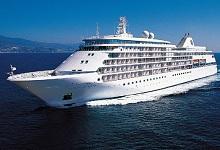Recently Viewed Cruises
- Shadow, Voyage 3311 ex Hong Kong to TokyoAdd to favourites
- Pacific Princess, World Cruise 2013 Sector ex Sydney to Hong KongAdd to favourites
- Pacific Princess, World Cruise 2013 Sector ex Sydney to DubaiAdd to favourites
- Pacific Princess, World Cruise 2013 Sector ex Sydney to VeniceAdd to favourites
- Nautica, Emperors & Empires ex Hong Kong to BangkokAdd to favourites
- Oceanic Discoverer
- Ab Fab Oosterdam
- Catch up on Cruising: Latest cruise news in bite size
- Catch up on Cruising: Latest cruise news in bite size
- Catch up on Cruising: Latest cruise news in bite size
- Frequently Asked Questions
-
Shadow, Voyage 3311 ex Hong Kong to Tokyo
Nights 14 Ship Silver Shadow Star Rating 
Departs Hong Kong Sailing 2013: 22 Apr Ports of Call Hong Kong, Shanghai, Jeju, Busan, Fukuoka, Hiroshima, Osaka, Tokyo Select a sailing date for approximate pricing.
Prices are per person, twin share. When booking please check current cruise fare and inclusions. Prices are indicative only, subject to currency fluctuations and may change at any time without notice.
14 Night Cruise sailing from Hong Kong to Tokyo aboard Silver Shadow.
Launched in 2000, Silver Shadow introduced guests to the next generation of the Silversea fleet - slightly larger in size, yet just as intimate in feel. In addition the the added space, guests aboard the Shadow are greeted with Silversea's six-star personalised service and attention to detail. The Shadow is as elegant as a grand hotel, as gracious as a long-time friends' home. Each all ocean-view suite provides a sumptuous retreat. Each public space is intimate yet inviting. It's a warm feeling of home upon the seas of the earth.
Aboard Silver Shadow you will find a most accommodating place to view our world. Whether it's delicious onboard diversions, world-class cuisine, memorable dining venues or staying connected from anywhere, Silversea's impeccable standards apply to every detail of your voyage.
Highlights of this cruise:
Hong Kong
Hong Kong Island and Kowloon are divided both physically and psychologically by Victoria Harbour. On Hong Kong Island, the central city stretches only a few kilometers south into the island before mountains rise up, but the city goes several more kilometers north into Kowloon. In the main districts and neighborhoods, luxury boutiques are a stone's throw away from old hawker stalls, and a modern, high-tech horse-racing track is just around the corner from a temple housing more than 10,000 buddhas.
Shanghai
Shanghai, one of the most vibrant and exciting Chinese cities, once known as the Paris of the East, now calls itself the Pearl of the Orient. A port city, lying at the mouth of Asia's longest and most important river, Shanghai is famous as a place where internationalism has thrived. Today the city draws more parallels to New York City than Paris. It is laid out on a grid (unlike sprawling Beijing), and with a population of 16 million, it is one of the world's most crowded urban areas. The Shanghainese have a reputation for being sharp, open-minded, glamorous, sophisticated, and business-oriented, and they're convinced they have the motivation and attitude to achieve their place as China's powerhouse. Shanghainese enjoy one of the highest living standards in China. Higher salaries and higher buildings, more business and more entertainment-all these define the fast-paced lives of China's most cosmopolitan and open people.
Hiroshima
In the early hours of August 6, 1945, the city of Hiroshima witnessed firsthand the devastating effects of the latest advances in military technology by becoming the first city ever levelled by an atom bomb. The bomb's force tore through the city in seconds, and its radioactive cloud settled like a funeral shroud. The casualties: 51,787 of 76,327 buildings were completely destroyed by the atom bomb, 6,180 buildings were partly-damaged and about 140,000 people died by the end of 1945.
A new Hiroshima emerged from the ashes, spreading a message of peace and warning future generations of the horrors of nuclear warfare. The city's zest for life is a testament to human resilience. Today, Hiroshima is a busy and prosperous city. Its inhabitants have built a thriving, liveable and diverse community attracting a steady flow of both Japanese and foreign business. The modern city is criss-crossed with rivers and wide, tree-lined boulevards and boasts some excellent museums. It is also the gateway to cruises on the Inland Sea and trips to Miyajima, an enchanting island just off the coast.
Hiroshima's history dates back to 1589, when the feudal lord Mori Terumoto named the city and built the Hiroshima Castle, which was reconstructed in 1958.
Tokyo
Of all major cities in the world, Tokyo is perhaps the hardest to understand or to see in any single perspective. To begin with, consider the sheer, outrageous size of it. Tokyo sprawls 88 km (55 mi) from east to west and 24 km (15 mi) from north to south. It's an area of 590 square km (228 square mi) that houses some 8 million people. Tokyo has no remarkable skyline, no prevailing style of architecture, no real context into which a new building can fit. Every new project is an environment unto itself. Architects revel in this anarchy, and so do the designers of neon signs, show windows, and interior spaces. The kind of creative energy you find in Tokyo could flower only in an atmosphere where there are virtually no rules to break.







